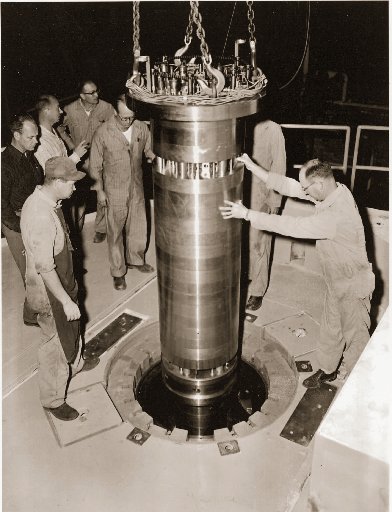At left, the assembly of a proof-of-concept breeder reactor EBR-1 , 1951. Not very big, is it?
The breeder reactor is a curious thing. Automajically, it is able to create more fissile material than it burns by bombarding a "blanket layer" of unreactive material and turning it into a fissile isotope able to fuel its own chain-reaction.
It's nuclear science. Alchemy on the atomic level. I won't endeavor to explain it here. Trust me on this one: it works.
Kim Jong-un is living proof.
Though, there is an odd bit of speculation that suggests the Nazi's might have been farther along than we public think with their nuclear science. I find this concept a little off but hey, when Bigfoot is on Letterman I'll look like an idiot then, too.
A reactor pile from Nazi Germany was found and disassembled. We know they had real trouble managing the criticality (keeping it working from a sustained reaction).
Of course, not everything one tries works the first time and the Germans were great at trying many different things in many different groups. Intellectual capital they had aplenty. Maybe we found the project that got a "D" that semester.
Case in point:
Submarine U-234 (now THAT is a confusing moniker in this context) surrendered to an American destroyer at the end of the war. She was a converted mine layer bound for Japan with a disassembled Me-262 jet fighter, a radio-controlled glide bomb (300KG warhead), what her captain said were fifty lead cubes labeled U-235, mercury, technical drawings and some special passengers. The navy reports listed 1200 pounds of unenriched U-238 as well.
Today, given these materials, a reasonably competent mad scientist could produce a fast breeder reactor, create sufficient fissile plutonium Pu-239 to fuel an atomic weapon, deploy such a weapon in a copy of the glider weapon, and kill a modern aircraft carrier.
This is possible with knowledge and the inventory of the submarine.
The problem: Glen Seaborg didn't isolate plutonium as a known element until 1940. [ He won the Nobel in 1951 and while still living, had element 106 named Seborgium in his honor. That's a pretty big deal. ]
Did the Germans know of Plutonium and its uses as a fissile source? Unlikely. Did they master a fast breeder reactor (the mercury would be a moderator for such a reactor if one were desperate. A liquid metal reactor doesn't tend to blow up like steam-producing liquid cooled reactors do) ?
I seriously doubt the Germans mastered a way to generate plutonium or to master the design of a fast breeder reactor. I will qualify this assertion by saying a fast breeder with no power production requirement is a pretty simple beast to build. Got a used envelope? We can do the math on the back.
Do we know everything about the German atomic program? No. Unlike the Nazi Germany rocket program (aka , NASA for three decades), we didn't quite embrace "atoms for peace" with what we discovered about the axis technical prowess in nuclear engineering. There were lots of reasons for this policy.
Thanks to Uncle Harry and the Atomic Energy Act of 1946, we didn't share any of our knowledge of advanced nuclear design - civilian or military - with even our closest allies for years.
The Brits almost killed the countryside making plutonium at Windscale in 1957.
The help the Americans had extended before this accident was "don't put water on the graphite fire your're going to have one day ... it makes it worse" and , especially helpfully: "those graphite blocks you built the reactor out of that you think are inert ...well, they grow after you irradiate them for a bit - and they release heat energy oddly after you get them nice and glowing."
The Brits responded "thanks so much" and proceeded to cram the thing with every bit of radioactive matter they could find.
One day, during tea - it all went to hell. To their credit, they didn't catch the graphite on fire. They caught the uranium fuel in the reactor face on fire.
Milk from 500 sq KM of farmland downwind was poured in the Irish sea for the next month as the Iodine-131 took a while to decay. Really, that's a 20 x 25 km patch of land and that's not so bad. Made pudding a bit expensive for a while, though.
Anyway, speculative fiction is fun. It requires a little suspense of belief.
I would say that if you gave U-234 to me in 1945, I'd have sunk at least one battle group. I'd of at least dramatically lowered the price of real estate in Honolulu.
The question is, if you give U-234 to the Japanese in 1945, could they do anything with its cargo?
There's your novel. Go to it.
I'm off to write my novel.
Don't drink coffee near those pages you're working on. The electrons won't like it when the spill you have one day soaks into your motherboard and corrodes it.
Carry on.


2 comments:
I love stories that present alternate histories. They're really just so much fun to read. The nuclear history is pretty interesting, too...imagining ways to rewrite history.
Kim Jong-un...ha!
All it takes is a little Wallace and Gromit and you're hooked on speculative fiction and alternate histories.
Must go use the mind-o-matic now. "I'm inventing mostly."
Post a Comment